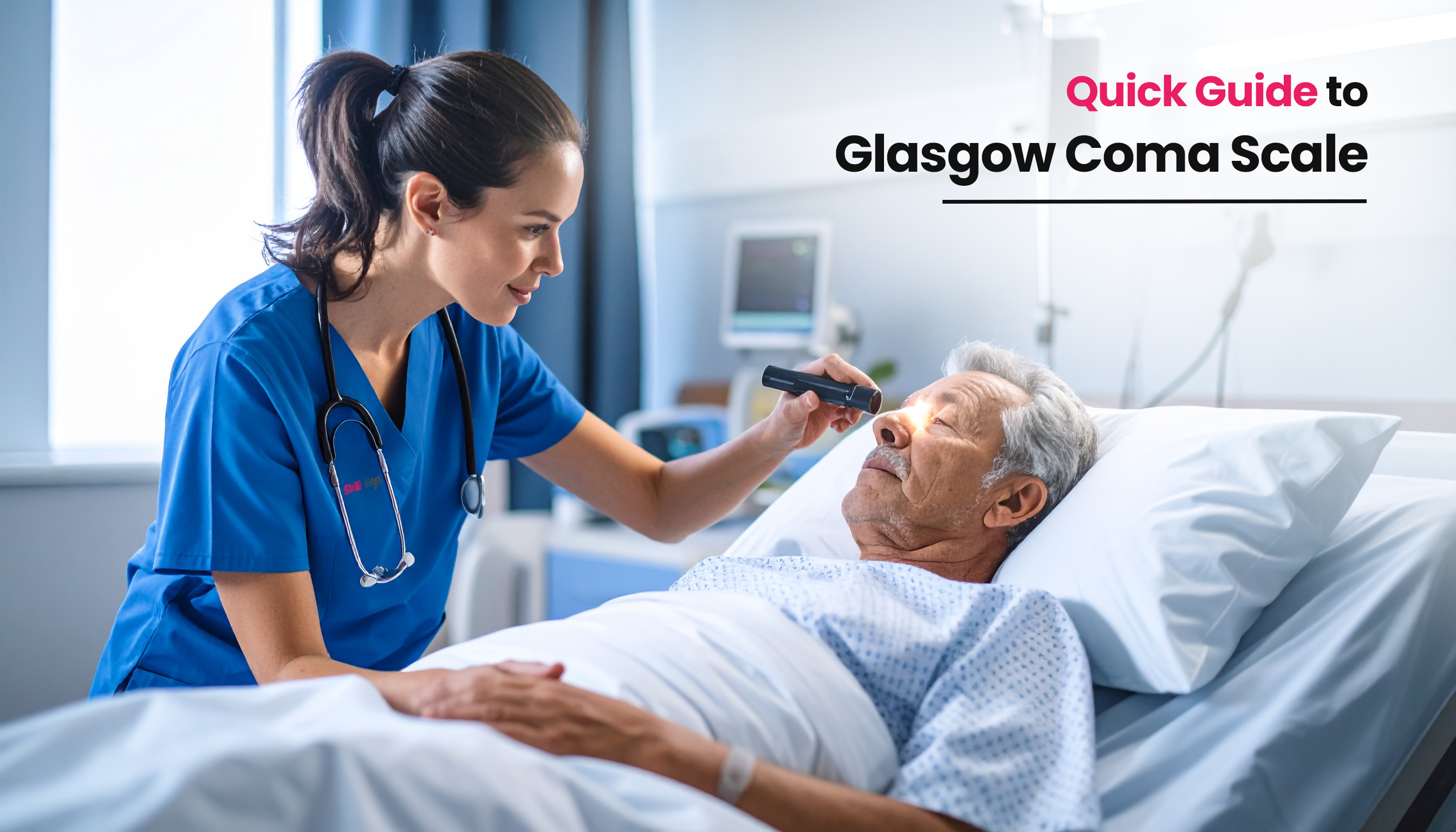Glasgow Coma Scale (GCS) is an important tool that helps nurses and the whole team to understand what is happening with the patient’s brain. During emergencies, nurses don’t have much time and therefore Glasgow Coma Scale (GCS) becomes the most important and reliable tool in healthcare to assess and communicate a patient’s level of consciousness. It is important for nurses to master the Glasgow Coma Scale (GCS) because it helps nurses to catch and assess the change before it is too late. In this blog, we will discuss everything you need to know about Glasgow Coma Scale, its scoring, uses and interpretation.
What is Glasgow Coma Scale?
Glasgow is a tool used by healthcare professionals and nurses to measure the patient’s level of consciousness after brain injury. It was developed by two neurosurgeons in 1974, Graham Teasdale and Bryan Jennett. Glasgow Coma scale (GCS) allows objective assessment, consistent documentation, and effective communication with healthcare team.
Categories of Glasgow Coma Scale (GCS) and scores
We know that Glasgow Coma Scale allows nurses and healthcare providers to measure the level of consciousness (LOC) of the patients based on these three categories:
- Eye opening (E)
- Verbal response (V)
- Motor response (M)
Eye opening
Measure how well patients can open their eyes to the stimuli:
- Score 4 (Spontaneous): Opening eyes on their own
- Score 3 (To speech): Open eyes when spoken to patients.
- Score 2 (To pain): Open eyes to painful stimulus
- Score 1 (To none): Not opening eye.
Verbal response (V)
This shows the verbal response of the patient. score and response with examples are as follows:
- 5 (Oriented): person knows the time, date and what is happening.
- 4 (Confused): Can talk but are confused.
- 3 (Inappropriate words): Random speech and no conversation.
- 2 (Incomprehensible sounds): Sounds like moaning or groaning.
- 1 (None): No verbal response from patient.
Motor response (M)
This helps nurses to evaluate the movements of the patients in response to commands or pain. The score and examples of response are as follows:
- 6 (Obey commands): Patients can follow simple commands.
- 5 (Localize pain): Patient purposely moves to remove the painful stimulus.
- 4 (Withdraws from pain): Moves away from painful stimulus.
- 3 (Abnormal flexion): Pain is applied to the patient, the arms flexed, and legs extended.
- 2 (Abnormal extension): Pain is applied to the patient, arms and legs extended rigidly.
- 1(None): No motor response from the patient.
How to calculate and interpret GCS score?
To calculate GCS score, add up the best responses. The total GCS score ranges from 3 to 15.
E+V+M
Score interpretation is as follows:
- Mild: GCS is 3-8
- Moderate: GCS is 9-12
- Severe: GCS is 13-15
Patient with Glasgow Coma Scale score of 7 or less is considered and comatose. And patients with GCS score of 8 or less is considered to have severe head injury.

Step-by-step guide for nurses to get GCS score of the patient
Here is step-by-step guide on how to take GCS score of the patient with brain injury.
- Ensures patient safety.
- Start with eye response.
- Then note verbal response of the patient.
- Test the motor response of the patient.
- Record the score.
- Reassess frequently especially head injury patients.
- Document clearly by noting both the individual and total score.
What are the limitations of GCS (Glasgow Coma Scale)
Some of the limitations of GCS scale are as follows:
- Intubated patients.
- Heavily sedated patients.
- Young children.
- Patients with hearing loss or speech impediment.
- Paralysis.
- Spinal cord damage in patients.
- Alcohol and drugs.
- Baseline psychological issues.
Example of Glasgow Coma Scale
Patient comes to the hospital after a car accident. To calculate its GCS score, you have to first take note of each score individually such as
Take individual scores:
Eye movement (E): 3
Verbal response (V): 4
Motor response (M): 5
Now add E+V+M:
3+4+5=12/15
The total score is 12 which means the patient has a moderate head injury.
What is the purpose of Glasgow Coma Scale in nursing?
- It helps nurses to quickly assess the level of consciousness in patients after a head injury.
- It helps nurses to track the changes over time of the patients.
- GCS provides a standardized way to help healthcare professionals communicate patient’s neurological status.
- GCS score helps nurses to prioritize urgent interventions.
- It also ensures proper documentation for legal purposes and ongoing treatments.
What is the Pediatric Glasgow Coma Scale (PGCS)?
- Eye-opening: Same as adult for example, opening eyes to pin or voice.
- Verbal response: Using age-appropriate responses such as coos, cries, irritable or no response.
- Motor response: Using age-appropriate responses such as spontaneous, withdrawal, abnormal posturing or none.
The PGCS total score is the same as adult from 3-15. The lowest score indicates a more severe condition of the patient.
What are the three main components of the Glasgow Coma Scale (GCS)?
The three main components of GCS are as follows:
Eye-opening (E)
Verbel response (V)
Motor response (M)
How to interpret mild, modest, and severe brain injuries using GCS?
- If the GCS score is 13-15 this means it is mild.
- Moderate brain injury GCS scoring is 9-12.
- Severe brain injury: GCS score is less or equal to 8.
How often should nurses assess GCS in ICU patients?
- For critically ill patients, it should be every 1 to 2 hours.
- For stable patients, nurses should assess GCS score every 4 hours.
- After surgeries such as sedation, intubation etc, GCS should be assessed more frequently, such as every hour.
What does Glasgow Coma Scale score of 8 indicate in patients?
If the GCS score in a patient is 8, then it means the patient is suffering from severe head injury.
Conclusion
Glasgow Coma Scale (GCS) is a quick, standardized and objective tool that helps nurses and other healthcare professionals to assess the patient’s neurological status after head injury. GCS consist of three components such as eye opening (E), verbal response (R), and Motor Response (M). The GCS scores tell the nurses if the condition of the patient is mild, moderate, or severe. The best way to interpret the GCS score is that first you have to add E+V+R and if the score is 13-15, then this means the condition of the patient is mild. If the score is 9-12, then this means that the condition of the patient is moderate and if it is 8 or less than 8, then it means the patient’s condition is severe.
If you are a travel nurse and want to make more money, download the SkillGigs app and become part of our travel nursing world, where you find travel nursing assignments with competitive pay, benefits and so much more. Sign up now and become part of our travel nursing world.






